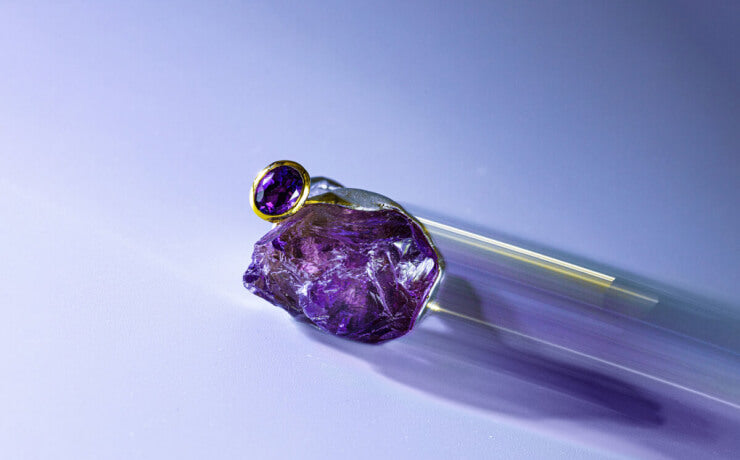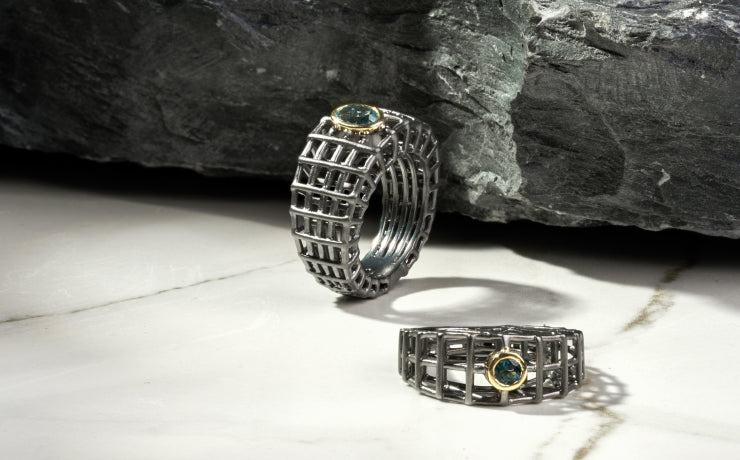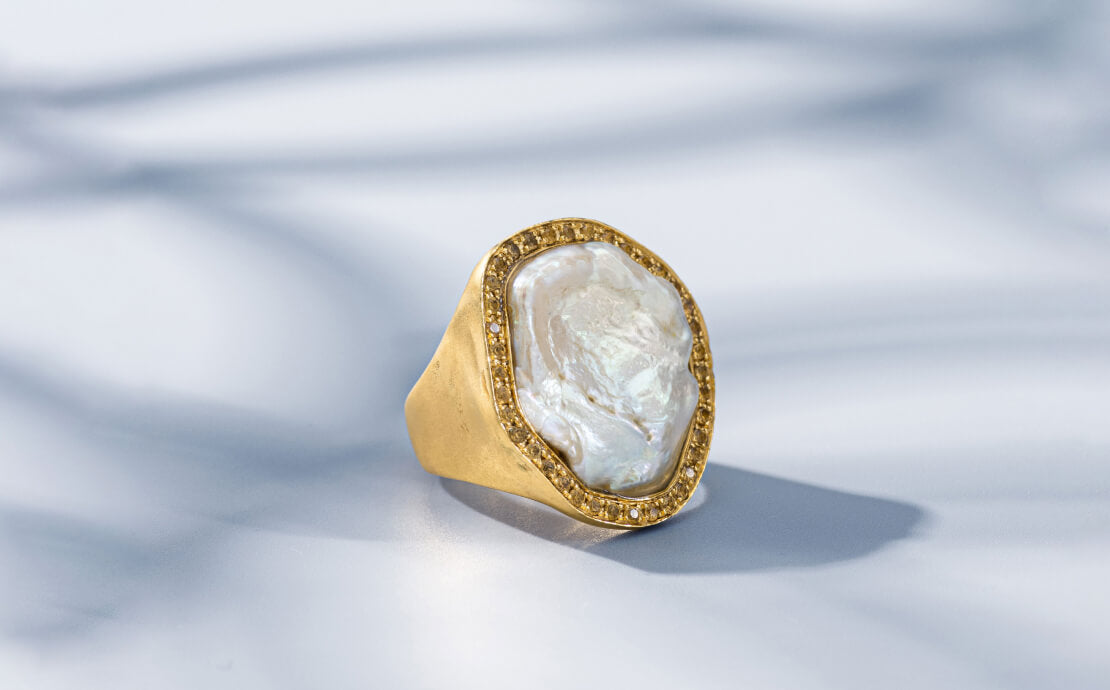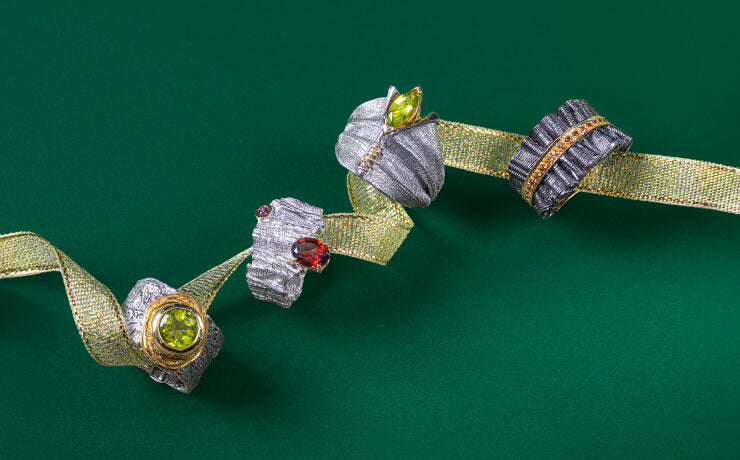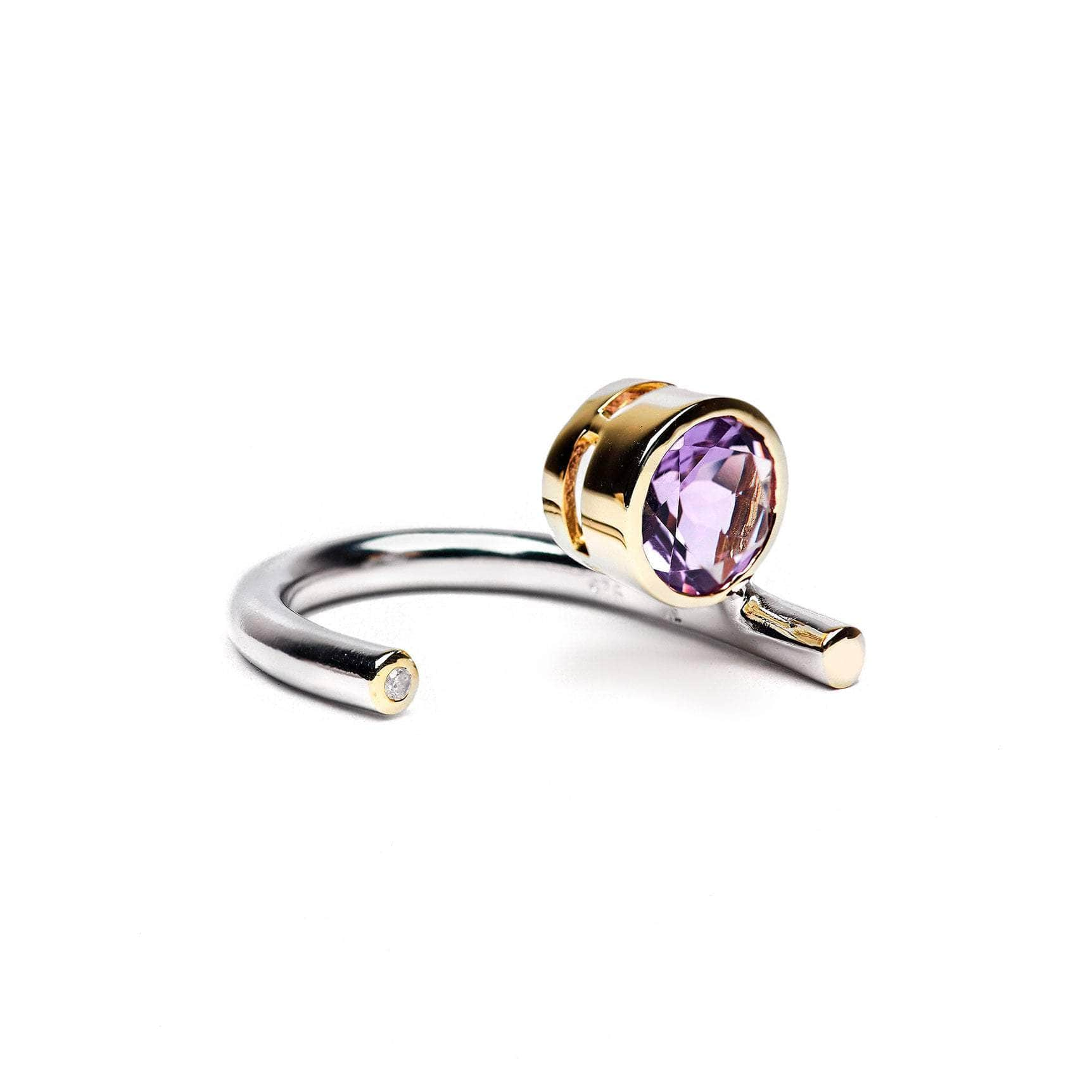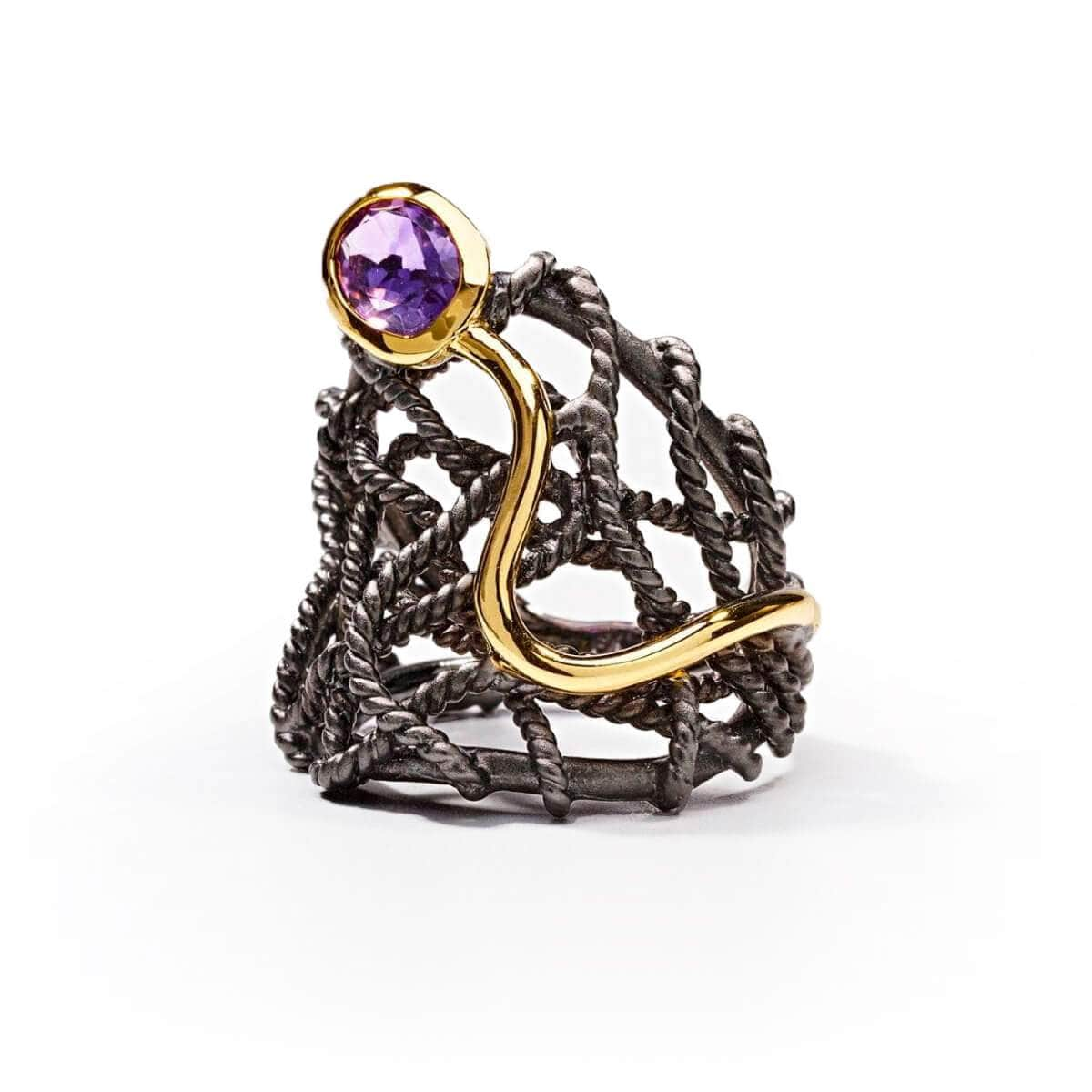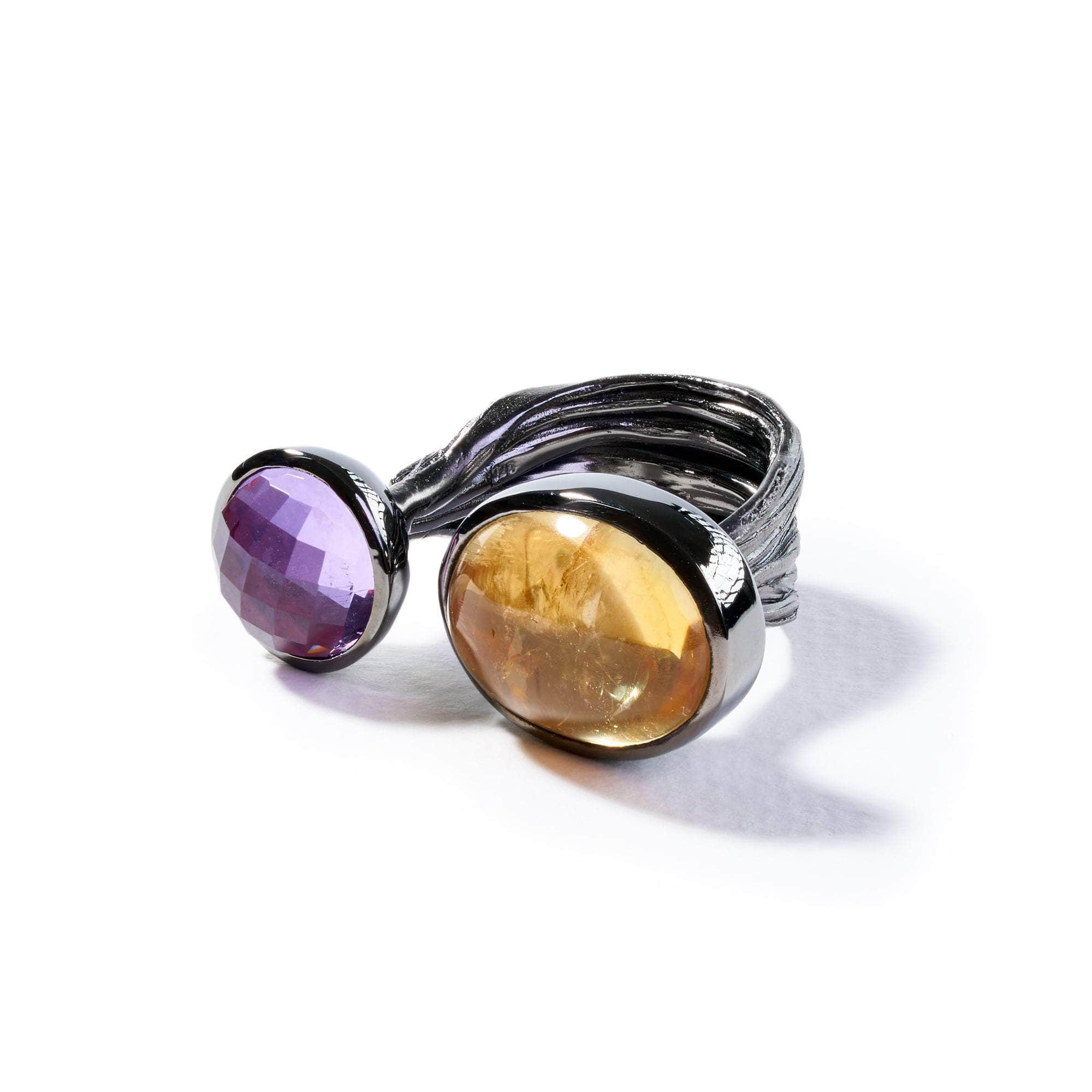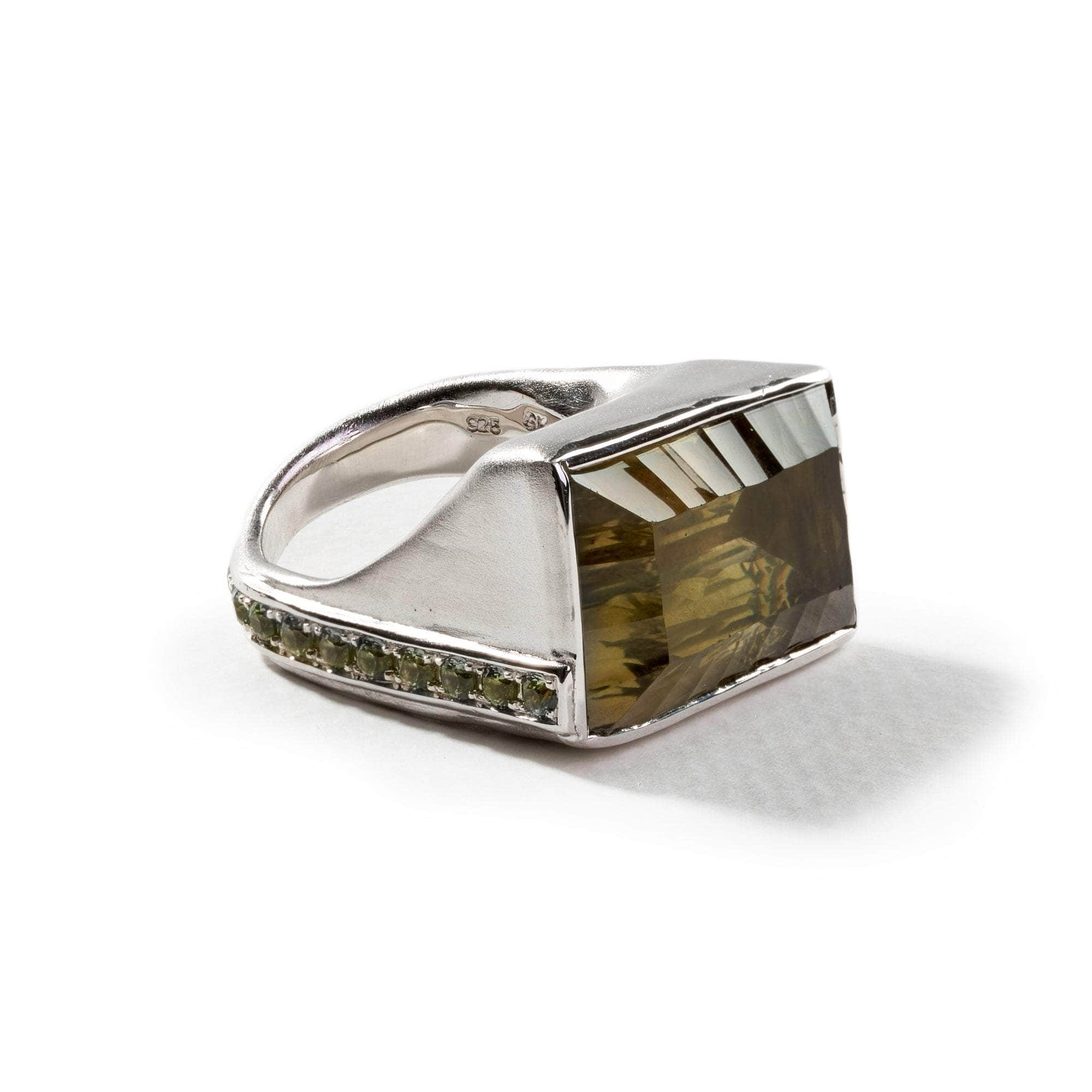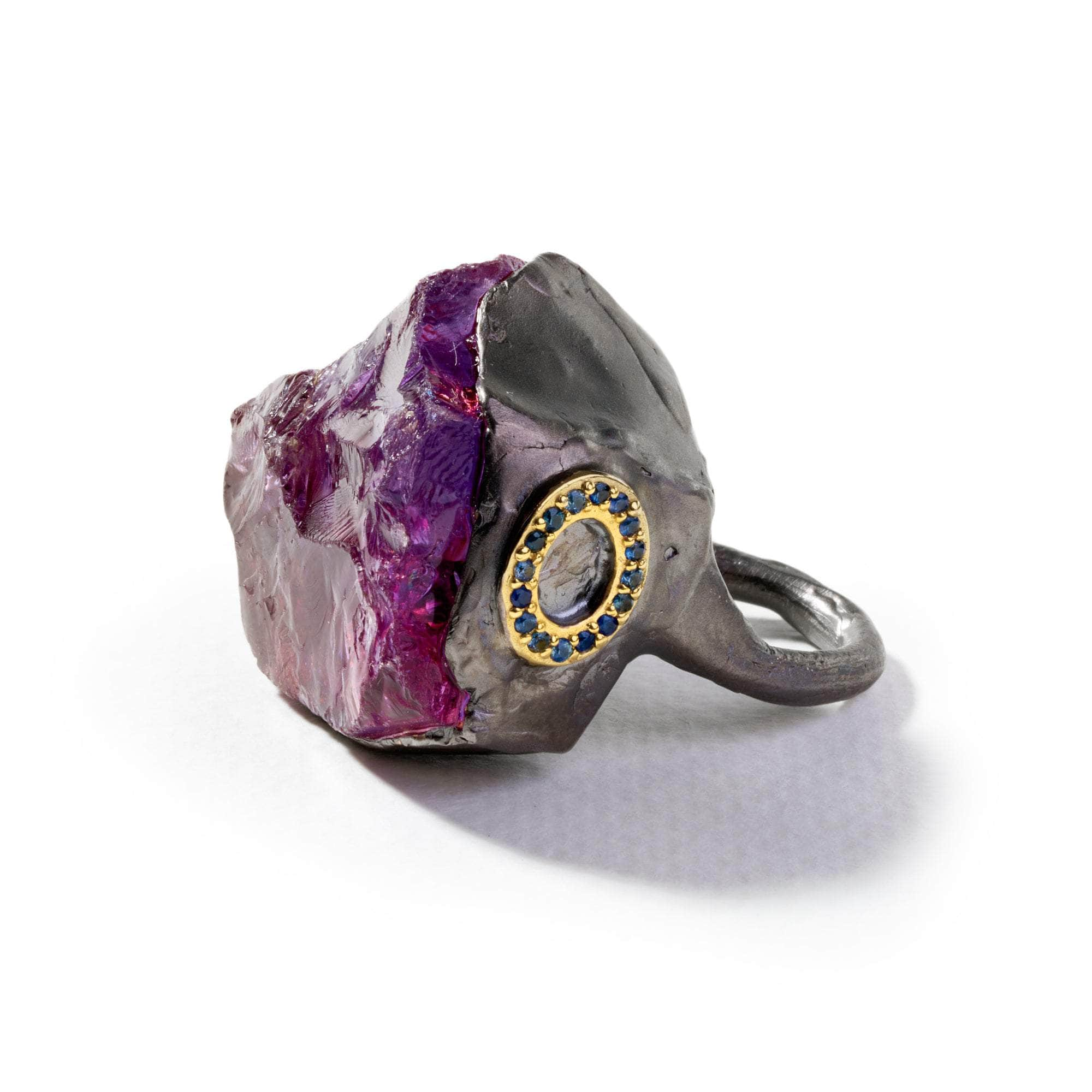Exploring Amethyst: February's Birthstone as a Wearable Art Gem
How German Kabirski Works Natural Amethyst in Modern Jewelry Design
Amethyst, a violet-hued gemstone, is a member of the quartz family, prized for its beauty and historical significance. Renowned for its vivid purple coloration ranging from pale lilac to deep, rich hues, this gemstone has captivated human kind for centuries. The name "amethyst" is derived from the Greek word "amethystos," which translates to "not intoxicated." Ancient Greeks believed that wearing amethyst could prevent drunkenness and promote sobriety. This gemstone has a rich lore steeped in various cultures, often associated with calmness, clarity, and protection from negative energies.
Geologically, amethyst forms within volcanic rocks and geodes, typically originating from silica-rich solutions. Its vibrant purple color results from irradiation and the presence of trace elements like iron. Amethyst is widely sourced across the globe, with major deposits found in countries such as Brazil, Zambia, Uruguay, and Russia. Its popularity in jewelry-making dates back to ancient times, adorning royal regalia and religious ornaments. Apart from its use in jewelry, amethyst also holds a place in spiritual practices, believed by some to possess healing properties and enhance spiritual awareness and intuition. Its versatile appeal and striking color make it a beloved gemstone for both jewelry enthusiasts and collectors worldwide.
Amethyst Through the Ages: Gems of Regality and Reverence in Historical Narratives
Throughout history, amethyst has held a revered place not only for its stunning beauty but also for its association with royalty, spirituality, and cultural significance. Its deep purple hues have adorned the crowns, jewelry, and ceremonial artifacts of monarchs and leaders worldwide. Here are a few notable instances of famous amethyst gemstones that have left an indelible mark on history:
The Siberian Amethysts
Historically, some of the most renowned amethysts came from Russia's Ural Mountains, particularly Siberia. These amethysts were highly coveted for their deep, rich color and were used in royal jewelry for centuries.
The British Crown Jewels
The British Crown Jewels house several significant amethysts. One of the most notable is the Kent Amethyst Parure, which includes a necklace, earrings, brooches, and a tiara. This parure was made for Queen Victoria's mother, the Duchess of Kent.
The Bishop's Amethyst
The Bismarck Sapphire Necklace, a famous piece of jewelry in the Smithsonian Institution, features a large amethyst once belonging to Pope Pius IX. The amethyst is surrounded by sapphires and diamonds, creating a stunning necklace with historical and religious significance.
Catherine the Great's Amethysts
Catherine the Great, Empress of Russia, possessed a significant collection of amethyst jewelry. She had several pieces adorned with large amethysts, showcasing their prominence in royal collections during her reign.
The Brazilian Amethyst Geodes
Brazil is known for producing large amethyst geodes. Some of these geodes have impressive sizes and remarkable crystal formations, becoming prized specimens in museums and private collections globally.
These historical instances highlight the enduring allure and cultural importance of amethyst, showcasing its role in both adornment and fascination throughout the ages.
Amethyst: Exploring Spiritual Beliefs and Healing Attributes
Amethyst, beyond its captivating beauty, has been attributed with various mystical properties and metaphysical significance across cultures and civilizations. Throughout history, this gemstone has been revered for its purported ability to influence the spiritual, emotional, and physical realms. Associated with qualities of tranquility, clarity, and protection, amethyst is believed by some to hold potent energies capable of calming the mind and enhancing spiritual awareness.
One of the most prevalent beliefs surrounding amethyst is its association with sobriety and preventing intoxication. Ancient Greeks held the belief that wearing or carrying amethyst could safeguard against drunkenness, leading to its name derived from the Greek word "amethystos," meaning "not intoxicated." This belief extended to the Middle Ages, where amethyst was used in amulets and goblets with the notion that it could ward off the effects of alcohol and promote clear thinking.
Spiritual practitioners often consider amethyst as a stone of higher consciousness and enlightenment. It is believed to stimulate the third eye chakra, fostering intuition and aiding in meditation practices. Some individuals use amethyst to connect with their inner selves, seeking spiritual growth, and accessing higher states of consciousness. Its calming energy is thought to alleviate stress and anxiety, promoting a sense of peace and emotional balance.
Additionally, amethyst is associated with protection against negative energies and psychic attacks. It's believed to create a protective shield that purifies the aura, dispels negative influences, and guards against spiritual and emotional negativity. This protective quality has made amethyst a popular choice for those seeking to create a harmonious environment in their living or working spaces.
Furthermore, amethyst is considered a stone of healing, both physically and emotionally. It's believed to have the power to alleviate ailments related to the nervous system, headaches, and sleep disorders. Some practitioners also use amethyst for its purported ability to aid in overcoming addictions and breaking unhealthy patterns by promoting clarity of thought and strengthening resolve.
In holistic healing practices like crystal healing and Reiki, amethyst is often utilized for its calming and purifying properties. Practitioners place amethyst crystals on specific parts of the body or incorporate them into healing sessions to restore balance, promote spiritual growth, and enhance overall well-being.
While scientific evidence supporting these mystical properties is limited, the belief in amethyst's metaphysical abilities continues to endure, making it a sought-after gemstone for those seeking spiritual growth, clarity, and emotional balance. Whether worn as jewelry or used in spiritual practices, amethyst remains a symbol of tranquility and inner strength for many individuals.
Amethyst's Celestial Affinity: Connecting Birth and Cosmic Harmony
Ancient civilizations believed in the alignment of gemstones with astrological signs, associating particular stones with specific months of birth. In astrology, amethyst is linked to the zodiac sign of Pisces, spanning from February 19 to March 20. This connection is rooted in the belief that amethyst can enhance the attributes and strengths associated with Pisces individuals. It's thought to amplify their intuition, creativity, and spiritual connection while offering protection against negative energies.
Moreover, amethyst is associated with the planet Jupiter, known as the ruler of Pisces in astrology. This connection further strengthens the belief in amethyst's ability to heighten Piscean traits and bring luck and prosperity to those born under this sign. Individuals often wear amethyst jewelry or keep amethyst stones close to them as a way to harness the celestial energies associated with their zodiac sign.
Beyond the realm of astrology, amethyst's significance in relation to birth extends to its association with the concept of a birthstone. Birthstones are gemstones linked to specific months and are believed to bring luck, protection, and unique qualities to individuals born in that month. Amethyst, as the birthstone for February, is cherished by those born in this month as a symbol of sincerity, inner strength, and peace.
According to folklore, wearing amethyst as a birthstone during February can enhance clarity of thought, bring emotional stability, and promote a balanced mindset. It's believed to align the wearer with positive energies and protect against negativity, offering a sense of harmony throughout life's journey.
This alignment between amethyst, stars, and birth has persisted through centuries, weaving a narrative that intertwines celestial energies, astrological influences, and the unique attributes of this captivating gemstone.
Amethyst's Meaning in German Kabirski's Freakaverse
While the captivating legends and mystical beliefs surrounding Amethyst's powers are fascinating, their authenticity remains a subject of speculation. However, what holds true is the unique integration of amethyst within German Kabirski's avant-garde jewelry. In the eccentric world of German Kabirski, amethyst serves as more than just a gemstone—it's a symbol of defiance against conformity.
German Kabirski's avant-garde designs transcend the conventional, embracing individuality and self-expression. When nestled within Kabirski's creations, amethyst becomes more than a mere adornment; it transforms into a talisman, empowering the wearer to break free from the mundane and mundane and mundane. Its energies are believed to fortify the spirit, offering the strength to swim against the tide, stand out from the crowd, and venture into uncharted territories of style and expression.
Within the Freakaverse of German Kabirski's visionary jewelry, amethyst symbolizes rebellion against the ordinary. It embodies the courage to embrace one's uniqueness, sparking a vibrant aura that defies conformity. It's not just a gemstone; it's a statement—a testament to the wearer's boldness, confidence, and refusal to blend in with the masses.
German Kabirski's contemporary jewelry pieces, with amethyst at their core, speak to those who seek more than just jewelry; they seek a reflection of their distinctive spirit. The amalgamation of amethyst within Kabirski's creations isn't merely aesthetic; it's a catalyst for self-empowerment, encouraging individuals to celebrate their eccentricities and shine brightly in a world that often prefers uniformity. In the Freakaverse, amethyst isn't just a stone; it's a beacon of individuality and empowerment.
Amethyst in Contemporary Jewelry Design: A Versatile Gem for Boundless Creative Options
Amethyst, in contemporary jewelry design, serves as a versatile gemstone that unlocks a multitude of creative avenues for designers. Beyond its aesthetics, its versatility becomes a tool for designers to explore diverse styles and craft pieces catering to various preferences. Its adaptability to different cuts, sizes, and settings makes it an ideal choice, seamlessly blending into modern designs while offering a wide spectrum of design possibilities.
Designers find amethyst to be a practical yet inspiring choice due to its diverse color variations and compatibility with varied metals and gemstones. Its flexibility allows for both minimalist, clean designs and more intricate, detailed creations. From sleek, modern settings to vintage-inspired motifs, amethyst stands out as a gem that harmonizes effortlessly with contemporary design aesthetics.
This gemstone's availability in various shapes, sizes, and finishes empowers designers to experiment, encouraging innovation and pushing the boundaries of conventional jewelry design. Amethyst's innate ability to complement different styles makes it a staple for contemporary designers seeking to create distinctive and impactful pieces that resonate with modern tastes while offering a touch of timeless elegance.
German Kabirski's Raw Amethyst: Embracing Nature's Imperfect Beauty
In German Kabirski's avant-garde designs, the use of raw amethyst crystals takes center stage, representing a departure from industry norms. While many jewelers opt for polished and refined stones, Kabirski's approach embraces the raw, unaltered beauty of amethyst in its natural form. These untouched crystals, placed in silver, stand as authentic representations of their origin, preserving their inherent energy and captivating allure.
German Kabirski's unconventional style extends to his admiration for the raw and unprocessed. The decision to showcase amethyst in its raw state speaks volumes about Kabirski's dedication to retaining the genuine essence of these gemstones. The unpolished, untamed appearance of these raw amethyst crystals serves as a testament to Kabirski's artistic philosophy—one that values imperfection as an intrinsic part of beauty and character.
Within Kabirski's innovative designs, raw amethyst crystals are not merely accessories; they're conduits to a world of organic beauty and energy. By leaving these stones unpolished and uncut, Kabirski ensures that each piece exudes a unique vibrancy, carrying the raw, unfiltered energy believed to be inherent in these natural formations.
In contrast to their polished counterparts, raw amethyst crystals are imbued with a dynamic presence. They encapsulate a world of inclusions, each telling a story of the stone's formation and journey. Kabirski's decision to showcase these imperfections, rather than eliminating them through cutting, is a deliberate choice that honors the beauty of natural irregularities.
Kabirski's unconventional use of raw amethyst crystals in his designs not only celebrates the stone's natural allure but also challenges the traditional standards of perfection. Each piece bearing these raw gems echoes Kabirski's belief that imperfections hold a unique charm and essence. In this way, Kabirski's creations become not just jewelry but representations of an artistic philosophy—one that embraces the raw, unrefined beauty found in nature's creations.
Conclusion: Amethyst Myths and Kabirski's Unorthodox Stance
In wrapping up, amethyst isn't just a pretty stone; it's a gem wrapped in stories and folklore, much like that curious legend of Dionysus and Amethystos. This ancient tale, whether truth or a figment of imagination, echoes the quirky allure of amethyst—a gem that's more than meets the eye.
German Kabirski, in his distinctive avant-garde jewelry, isn't one for the shiny, polished norms. His choice of raw amethyst flips the script. He digs the natural, unrefined beauty—the rough edges and imperfections. It's like wearing a piece of nature's funky art, honoring the wild side of a stone steeped in tales of sobering powers and ancient sagas.
It's funny how a tale from way back when weaved this stone into history, and here we are, Kabirski flipping the script again. He's all about embracing the natural quirks, letting those raw amethyst crystals rock their uncut charm. Imperfect? Sure. But in those flaws lie tales and energies, as if the stones hold secrets untold, waiting for curious minds to explore.
Just like that legend spun tales of protection and purity, Kabirski's raw amethyst pieces whisper a different story—a nod to individuality, embracing flaws, and giving a high-five to all things unconventional. Amethyst isn't about polished perfection here; it's about rawness, character, and the beauty of being different.
Amidst the tales, legends, and avant-garde designs, amethyst remains this cool kid—quirky, intriguing, and unapologetically itself. It's a stone with a backstory, wrapped in myths, and embraced by Kabirski's unconventional art, speaking a language that celebrates the beautifully imperfect in a world that often seeks flawless.
